Unit 4 Everyday economics Understanding ideas课件(共16张)--2024-2025学年高中《英语》选择性必修4(外研版)
文档属性
| 名称 | Unit 4 Everyday economics Understanding ideas课件(共16张)--2024-2025学年高中《英语》选择性必修4(外研版) |  | |
| 格式 | pptx | ||
| 文件大小 | 35.3MB | ||
| 资源类型 | 教案 | ||
| 版本资源 | 外研版(2019) | ||
| 科目 | 英语 | ||
| 更新时间 | 2025-07-13 09:59:53 | ||
图片预览

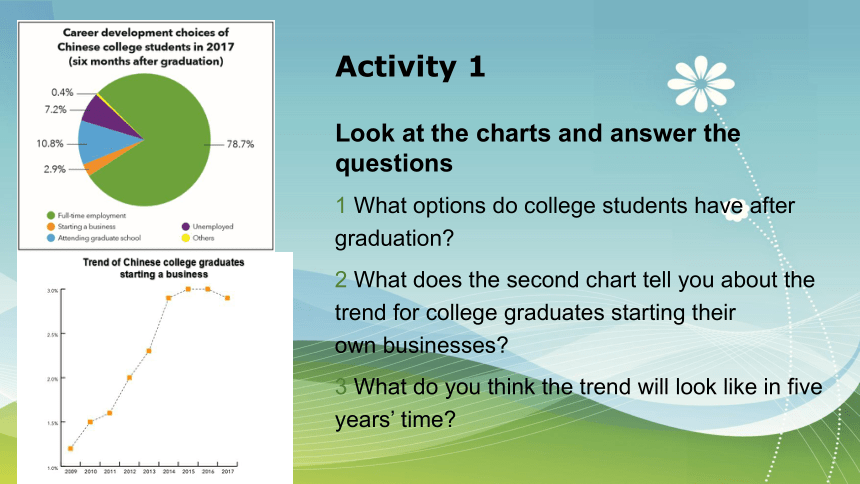

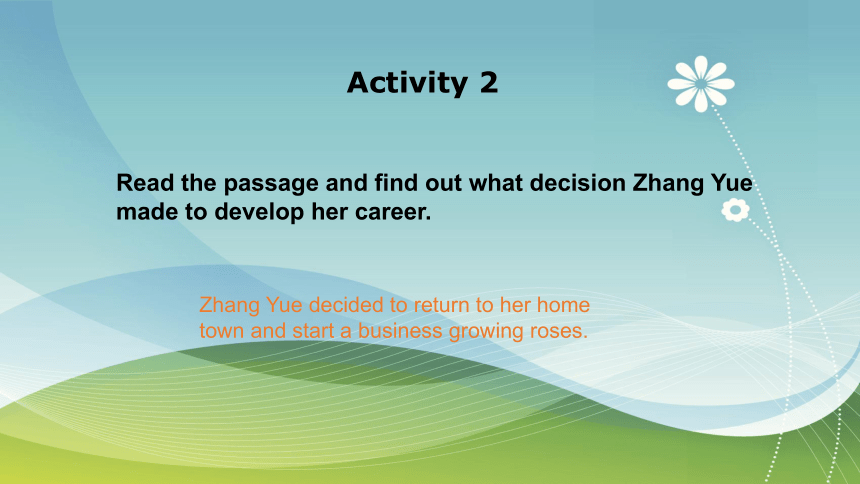
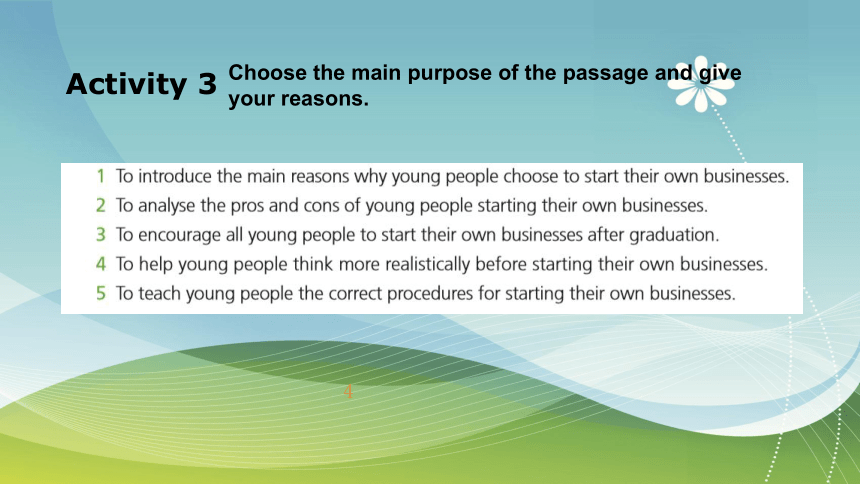
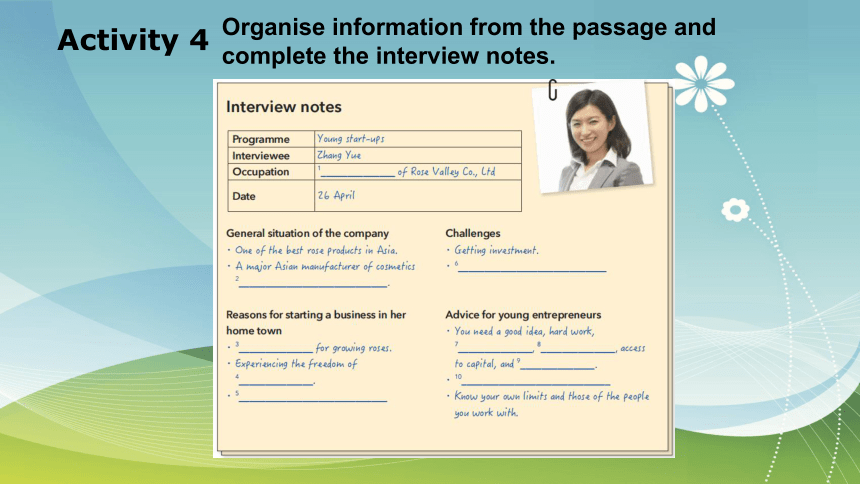
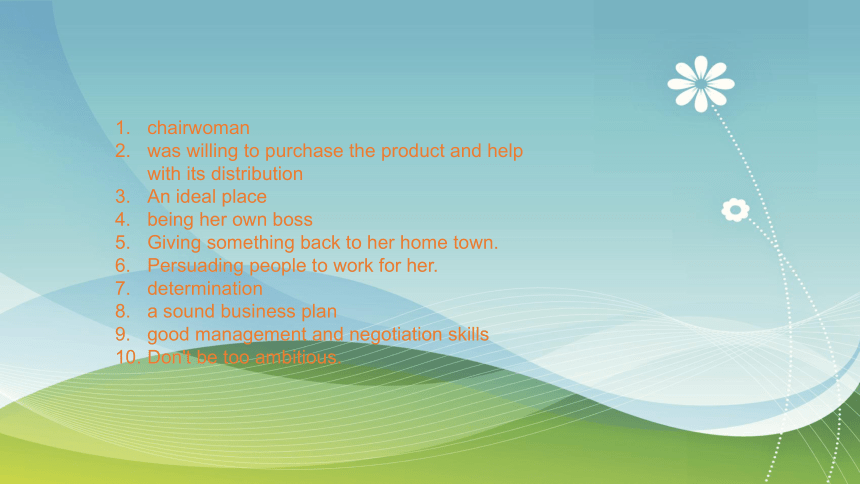


文档简介
(共20张PPT)
Unit 4 Everyday economics
Understanding ideas
新标准《英语》高中选择性必修第四册
Activity 1
Look at the charts and answer the questions
1 What options do college students have after graduation
2 What does the second chart tell you about the trend for college graduates starting their own businesses
3 What do you think the trend will look like in five years’ time
Trend of Chinese college graduates
starting a business
1. They can get a full-time job, pursue further education, or start their own business. They may choose not to have a job.
2. 1) From 2009 to 2015, the percentage of university graduates who started a business rose.
2) Between 2015 and 2016, the percentage remained almost at the same level, about 3%, while in 2017, the percentage declined.
Activity 2
Read the passage and find out what decision Zhang Yue made to develop her career.
Zhang Yue decided to return to her home town and start a business growing roses.
Activity 3
4
Choose the main purpose of the passage and give your reasons.
Activity 4
Organise information from the passage and
complete the interview notes.
chairwoman
was willing to purchase the product and help with its distribution
An ideal place
being her own boss
Giving something back to her home town.
Persuading people to work for her.
determination
a sound business plan
good management and negotiation skills
Don't be too ambitious.
Now work in pairs. Act out the interview based on the interview notes.
1 What do you think has contributed to Zhang Yue's success
2 What other difficulties do you think young people encounter when starting their own businesses
3 Have you ever thought about starting your own business,or would you rather do a white-collar job in an office Give your reasons.
4 How well do you understand the characteristics of a feature story Howare these characteristics reflected in the reading passage
ThinkShare
Unit 4 Everyday economics
Starting out
新标准《英语》高中选择性必修第四册
Activity 1
Watch the video and answer the questions
1 What is the video about
2 What stages are mentioned in the video What are they like
The video is about the development of money.
There are different stages in the development of money. Long before money was invented, people used a barter system to buy and sell things. A barter system is a way to exchange goods and services for other goods and services. Later, some goods became more widely accepted than others. These could be used to calculate the value of other products and services. One such item was salt. Around the 11th century BC, Chinese people started to use small piece of bronze to trade things. In the early stages, coins of different shapes were used. The coins were standardised in the Qin Dynasty and started to take a circular shape with a square hole through the middle. Around the year 1000, the Chinese began to use paper money. The Song Dynasty saw the introduction of jiaozi, which is said to be not only the first example of paper currency used in China, but also in the world. Today, we have a modern system of coins and paper notes, but this is continuing to change and develop to other forms.
Activity 2
Look at the pictures and answer the questions
1 What activities are shown in the pictures
2 What do they have in common
3 What other economic activities are part of your daily life
The pictures show some daily activities, namely paying coins for some vegatables, using an ATM card, donating money to people in need, paying through an app on a smartphone. (from top left to botto right)
These pictures all show types of economic behaviours, and they are all related to currency of various forms.
Unit 4 Everyday economics
Project
新标准《英语》高中选择性必修第四册
Investigate
Work in groups. Think about ideas for a new business.
Choose two or three of the best ideas and do research online to find out what similar businesses are already out there in the market.
Share your research and talk about how you might change your business plan in response.
Choose a business plan to pitch.
Plan
Develop your chosen business plan. Consider the following:
target market
branding
produce differentiation
and replacement
pricing
delivery
customer support
investment
potential return
other opportunities and risks
Create
Prepare a ten-minute pitch for your business idea. Think carefully about the key information to include, the order in which you will present it, who will be doing the presentation and how to make the presentation convincing.
Look for or create visuals such as charts and diagrams to support your pitch.
Rehearse your pitch and adjust it accordingly.
Present
1. As a group, present your business plan to the class. Find out what they like about your ideas and whether they have found any other potential opportunities or
risks.
2. When all the groups have given their pitch, vote for:
the most well-delivered pitch
the most creative business plan
the pitch most likely to be successful in the real world
THANK YOU
WPS,a click to unlimited possibilities
Unit 4 Everyday economics
Understanding ideas
新标准《英语》高中选择性必修第四册
Activity 1
Look at the charts and answer the questions
1 What options do college students have after graduation
2 What does the second chart tell you about the trend for college graduates starting their own businesses
3 What do you think the trend will look like in five years’ time
Trend of Chinese college graduates
starting a business
1. They can get a full-time job, pursue further education, or start their own business. They may choose not to have a job.
2. 1) From 2009 to 2015, the percentage of university graduates who started a business rose.
2) Between 2015 and 2016, the percentage remained almost at the same level, about 3%, while in 2017, the percentage declined.
Activity 2
Read the passage and find out what decision Zhang Yue made to develop her career.
Zhang Yue decided to return to her home town and start a business growing roses.
Activity 3
4
Choose the main purpose of the passage and give your reasons.
Activity 4
Organise information from the passage and
complete the interview notes.
chairwoman
was willing to purchase the product and help with its distribution
An ideal place
being her own boss
Giving something back to her home town.
Persuading people to work for her.
determination
a sound business plan
good management and negotiation skills
Don't be too ambitious.
Now work in pairs. Act out the interview based on the interview notes.
1 What do you think has contributed to Zhang Yue's success
2 What other difficulties do you think young people encounter when starting their own businesses
3 Have you ever thought about starting your own business,or would you rather do a white-collar job in an office Give your reasons.
4 How well do you understand the characteristics of a feature story Howare these characteristics reflected in the reading passage
ThinkShare
Unit 4 Everyday economics
Starting out
新标准《英语》高中选择性必修第四册
Activity 1
Watch the video and answer the questions
1 What is the video about
2 What stages are mentioned in the video What are they like
The video is about the development of money.
There are different stages in the development of money. Long before money was invented, people used a barter system to buy and sell things. A barter system is a way to exchange goods and services for other goods and services. Later, some goods became more widely accepted than others. These could be used to calculate the value of other products and services. One such item was salt. Around the 11th century BC, Chinese people started to use small piece of bronze to trade things. In the early stages, coins of different shapes were used. The coins were standardised in the Qin Dynasty and started to take a circular shape with a square hole through the middle. Around the year 1000, the Chinese began to use paper money. The Song Dynasty saw the introduction of jiaozi, which is said to be not only the first example of paper currency used in China, but also in the world. Today, we have a modern system of coins and paper notes, but this is continuing to change and develop to other forms.
Activity 2
Look at the pictures and answer the questions
1 What activities are shown in the pictures
2 What do they have in common
3 What other economic activities are part of your daily life
The pictures show some daily activities, namely paying coins for some vegatables, using an ATM card, donating money to people in need, paying through an app on a smartphone. (from top left to botto right)
These pictures all show types of economic behaviours, and they are all related to currency of various forms.
Unit 4 Everyday economics
Project
新标准《英语》高中选择性必修第四册
Investigate
Work in groups. Think about ideas for a new business.
Choose two or three of the best ideas and do research online to find out what similar businesses are already out there in the market.
Share your research and talk about how you might change your business plan in response.
Choose a business plan to pitch.
Plan
Develop your chosen business plan. Consider the following:
target market
branding
produce differentiation
and replacement
pricing
delivery
customer support
investment
potential return
other opportunities and risks
Create
Prepare a ten-minute pitch for your business idea. Think carefully about the key information to include, the order in which you will present it, who will be doing the presentation and how to make the presentation convincing.
Look for or create visuals such as charts and diagrams to support your pitch.
Rehearse your pitch and adjust it accordingly.
Present
1. As a group, present your business plan to the class. Find out what they like about your ideas and whether they have found any other potential opportunities or
risks.
2. When all the groups have given their pitch, vote for:
the most well-delivered pitch
the most creative business plan
the pitch most likely to be successful in the real world
THANK YOU
WPS,a click to unlimited possibilities
